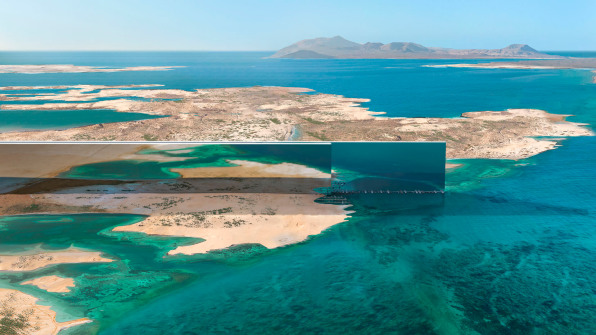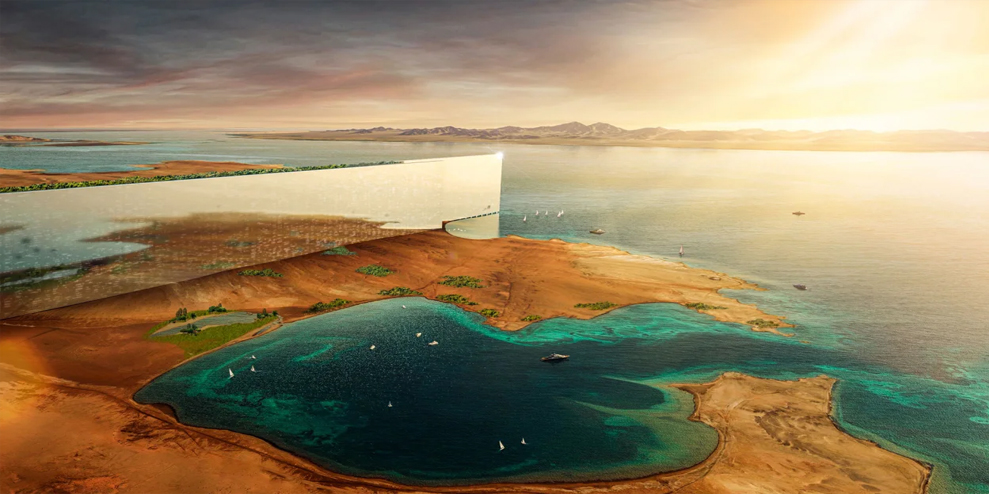A linear city in the desert is a provocative vision of the city of the future—but it’s been tried before.
Saudi Arabia’s proposal for a 105-mile-long building called the Line has all the stuff of a science fiction paperback. The stark desert setting. The kingdom in control of vast amounts of one of the planet’s most crucial resources. The long history of questionable human rights in that cloistered society. The ruler known for authorizing the grisly murder of a high-profile critic while also trying to remake his country’s image with a futuristic large-scale megaproject called Neom.
And then there’s the front-cover illustration: two mirrored skyscrapers housing 9 million people, climbing 1,600 feet high and cutting a straight, monolithic line through the sand.
The Line is a bold proposition, and one that critics have quickly blasted as little more than a very polished but hubristic architectural fantasy. In a recent press release announcing the design of the Line—no cars, 100% renewable energy, everything a resident could want or need within a five-minute walk—Saudi Crown Prince Mohammed bin Salman said “the city’s vertically layered communities will challenge the traditional flat, horizontal cities and create a model for nature preservation and enhanced human livability.”
A promotional animation shows a conventional city on a grid scooped up like sand on the beach into a dense column of packed urbanity.
Even with some ambitious ideas about walkable urbanism and technological solutions to the sustainability challenges of living in a changing climate, this proposal—experts in the history, function, and form of cities say—tests credulity.
But the concept of a linear city actually has deep roots in the world of urban design, according to Robert Fishman, a professor of architecture and urban planning at the University of Michigan and author of a book called Urban Utopias in the Twentieth Century.
One of the first proposed linear cities was designed for Madrid in the 1880s. “The reason that urban design keeps coming back to the linear city is that it really does have a functional logic,” Fishman says.

The linear city was framed as a solution to the challenge of accommodating a growing industry and the people working in that industry. Often based around a transportation corridor like a rail line, residences could be placed in one section and factories in another. This was in a time before zoning, when smoke-belching factories were often located in dense neighborhoods.
“The linear city was a necessary utopianism in response to the typical industrial district of the time, a visionary alternative to a really inefficient and inhuman environment,” Fishman says.
Saudi Arabia’s Line may just be a modern version of that alternative city planning. “I think we’re at a similar moment in terms of being stuck in these still unsustainable urban forms of sprawl and needing an alternative,” Fishman says.
Brenda Case Scheer is a professor of city planning at the University of Utah and the author of The Evolution of Urban Form. She says the linear city being proposed in Saudi Arabia is hardly a unique concept, but it also ignores some basic realities of the way cities take shape.
“Most cities aren’t designed. That’s a misnomer to begin with. Most cities grow from a small place to a large place over hundreds of years, and they start because they have a reason to start,” she says. “A city is not something that you just plunk down in the desert somewhere. It’s not a big house, and that’s what this sort of seems like.”
Renderings of the Line, designed by the architecture firm Morphosis, show a canyon of plant-lined balconies and building facades crisscrossed by park-like walkways and canals. (One executive working on the project even suggested children in the Line would be able to use those canals to swim to school.)
Scheer is skeptical of much of that vision, particularly the prospect of humans occupying the deep reaches of a city measuring just 650 feet wide.
“It’s an extremely dark vision. I mean that both literally and figuratively,” Scheer says. “You can’t have a breath of fresh air, you can’t grow a daisy on your front porch, you can’t even have weeds in the cracks of the sidewalk. It’s like an airport.”
Renderings do show natural light filtering down into the deep canyon of the Line, both from above and through its mirrored glass facades, but darkness and shadow in much of the space would be unavoidable.
The project’s promotional material does, understandably, paint a rosier picture, suggesting that it could be a new model for a sustainable city, one whose internal climate is controlled year-round and whose narrow footprint reduces the destruction of nature required to build a new metropolis.
Scheer argues that the embodied carbon required to build such a project would vastly outweigh whatever sustainability elements it implements, also noting that such a project would be unlikely to last long enough to even live up to its goal of becoming a city. “It’s a building, and buildings don’t last that long,” she says. “The bigger the building, the faster it becomes obsolete.”
And yet it’s not impossible for an instant city to rise in the desert, says Ethel Sara Wolper, a professor of history at the University of New Hampshire who has studied the history of cities in the Middle East.
“If you think about Dubai, it was this sleepy town that totally redid itself,” Wolper says. “It shows the limit of what you can create. And I think bin Salman likes to push those limits, like what can you create if you have all the money in the world?”
Whether utopia or dystopia, the Line proposes a tech-fueled update of idealized cities dating back to the 1800s, according to Fishman, who says, “None of this makes it particularly plausible as an actual project, but it has these interesting ties to speculation about how a really efficient future city might work.”
Scheer argues that while there may be technological means to construct this kind of project, it’s unclear why such a project is needed in a world chock-full of functioning cities.
“The thing that is interesting here is, well, you won’t have to have a car. But you don’t have to have a car on a Greek island, either, and you don’t have to have a car in the old medinas in Saudi Arabia,” she says. “The only reason to do that is to build a sort of prison for your people and keep them under complete control in darkness. This reveals more about the prince than it does about technology.”
Scheer calls the Line “a big, long symbol of power,” noting that even though the idea of a linear city is not new, very few have ever been built successfully. The best cities, she says, are the ones able to adapt to the changing needs of the people living in them, and to grow both upward and outward. Sort of like in that conventional gridded city the Line wants to sweep up.
“As an urban form,” Scheer says, “the grid is popular because it’s so flexible.”
—
This article first appeared in www.fastcompany.com
Seeking to build and grow your brand using the force of consumer insight, strategic foresight, creative disruption and technology prowess? Talk to us at +971 50 6254340 or engage@groupisd.com or visit www.groupisd.com/story

